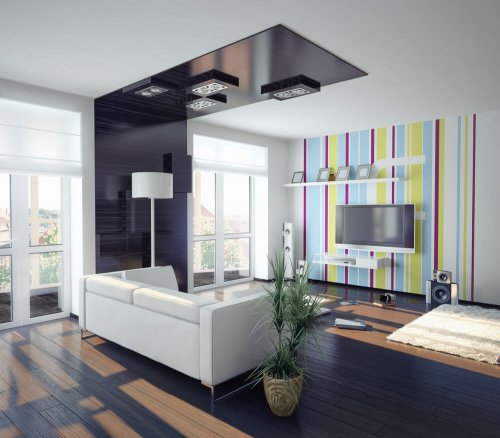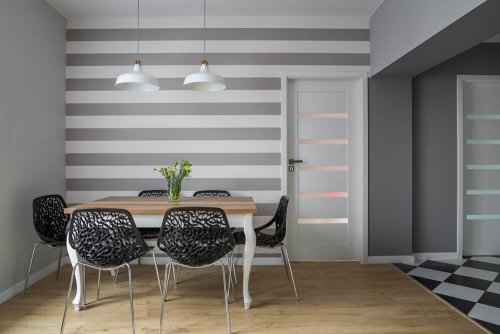Striped Walls - You'll Love the Results

Striped walls can help us liven up the decor in our living rooms, bedrooms, etc. In our post today, we’ll give you some ideas.
Striped walls have a huge visual impact. So, you’ll need to think about how they’ll blend in with the rest of a room. Sometimes, keeping a wall clear of paintings, posters, pictures is the better option…
On a different note, you need to know which kind of stripes will look best in your home. Stripes can be different widths and color combinations.
To keep the end result from looking too busy, leaving the walls solid while painting one with stripes is a great option. That way, the overall result will be more balanced. You should also avoid using other patterns in the same room because they will clash.
Below, we’ll explain what kinds of visual effects stripes (both vertical and horizontal) have on rooms.
Walls with vertical stripes
Vertical stripes are a great way to make rooms look bigger because they add height. The effect is perfect for small spaces. One of the most common problems for homes is the lack of space.
For striped walls, you have two options: wallpaper or paint.
If you’re going to paint the stripes yourself, choose a wall and paint it in a color that’s lighter than the color that you want for the stripes. When the wall is dry, use some masking tape or bands to cover the areas that you want to keep in the light color. Then, paint the open spaces in the other color. Make sure to use a high-quality tape to prevent any complications.

As for the stripe widths, paint them as wide or as thin as you like. But remember, the thinner the stripes, the more stylized the results will be.
On the other hand, you can also mix and match different widths, playing with the colors as well. One idea is making monochromatic sets with your stripes. To get the look, you’ll really have to think about your room’s current decor. That might entail your furniture, or the colors all of your accessory pieces from the decorative pillows, vases, and sofa covers to rugs.
Additionally, striped walls will also help create a stronger sense of organization in your room. Especially if you space them out evenly and paint all of them in the same width.
Walls with horizontal stripes
In the other corner, horizontal strips cut spaces short. Consequently, we only recommend them for bigger and/or taller rooms because they’ll counteract the effect; these spaces, despite the stripes, will still look big.
However, if you use really thick stripes in light colors, you can also create more visual space in addition to more depth. For these kinds of stripes, you should just use two colors, alternating them. If possible, try using white for one of them, or another very light color. If you want to use bolder or darker colors, however, you should use thinner stripes.
You can stylize horizontal stripes as well as long as you do so carefully. Plan your stripes with the psychology of colors in mind to create a balanced, harmonious end result that’ll make you feel comfortable in the room.

As we mentioned earlier in our post, if you use stripes on the wall, you should avoid using them for the decor accessories or furniture in the same room. If you do, however, try keeping the stripes a similar width and color. They’ll work best on small details – decorative pillows will work better than rugs or curtains, which have a bigger visual impact.
A safe bet for striped walls
As you’ve seen so far, decorating a wall or two with stripes can completely change your home. With stripes, you have to think about the size of your room and they type of stripe if you want to make it look bigger. If you have a big room, you can go with horizontal stripes, that’ll make it look a little smaller.
Think about all the possibilities that you have; you only need to vary the width, the spaces between the stripes and the colors. While using two colors is a popular way to go for striped walls, you can also go multi-color, making sure not to overwhelm the space.
Striped walls can help us liven up the decor in our living rooms, bedrooms, etc. In our post today, we’ll give you some ideas.
Striped walls have a huge visual impact. So, you’ll need to think about how they’ll blend in with the rest of a room. Sometimes, keeping a wall clear of paintings, posters, pictures is the better option…
On a different note, you need to know which kind of stripes will look best in your home. Stripes can be different widths and color combinations.
To keep the end result from looking too busy, leaving the walls solid while painting one with stripes is a great option. That way, the overall result will be more balanced. You should also avoid using other patterns in the same room because they will clash.
Below, we’ll explain what kinds of visual effects stripes (both vertical and horizontal) have on rooms.
Walls with vertical stripes
Vertical stripes are a great way to make rooms look bigger because they add height. The effect is perfect for small spaces. One of the most common problems for homes is the lack of space.
For striped walls, you have two options: wallpaper or paint.
If you’re going to paint the stripes yourself, choose a wall and paint it in a color that’s lighter than the color that you want for the stripes. When the wall is dry, use some masking tape or bands to cover the areas that you want to keep in the light color. Then, paint the open spaces in the other color. Make sure to use a high-quality tape to prevent any complications.

As for the stripe widths, paint them as wide or as thin as you like. But remember, the thinner the stripes, the more stylized the results will be.
On the other hand, you can also mix and match different widths, playing with the colors as well. One idea is making monochromatic sets with your stripes. To get the look, you’ll really have to think about your room’s current decor. That might entail your furniture, or the colors all of your accessory pieces from the decorative pillows, vases, and sofa covers to rugs.
Additionally, striped walls will also help create a stronger sense of organization in your room. Especially if you space them out evenly and paint all of them in the same width.
Walls with horizontal stripes
In the other corner, horizontal strips cut spaces short. Consequently, we only recommend them for bigger and/or taller rooms because they’ll counteract the effect; these spaces, despite the stripes, will still look big.
However, if you use really thick stripes in light colors, you can also create more visual space in addition to more depth. For these kinds of stripes, you should just use two colors, alternating them. If possible, try using white for one of them, or another very light color. If you want to use bolder or darker colors, however, you should use thinner stripes.
You can stylize horizontal stripes as well as long as you do so carefully. Plan your stripes with the psychology of colors in mind to create a balanced, harmonious end result that’ll make you feel comfortable in the room.

As we mentioned earlier in our post, if you use stripes on the wall, you should avoid using them for the decor accessories or furniture in the same room. If you do, however, try keeping the stripes a similar width and color. They’ll work best on small details – decorative pillows will work better than rugs or curtains, which have a bigger visual impact.
A safe bet for striped walls
As you’ve seen so far, decorating a wall or two with stripes can completely change your home. With stripes, you have to think about the size of your room and they type of stripe if you want to make it look bigger. If you have a big room, you can go with horizontal stripes, that’ll make it look a little smaller.
Think about all the possibilities that you have; you only need to vary the width, the spaces between the stripes and the colors. While using two colors is a popular way to go for striped walls, you can also go multi-color, making sure not to overwhelm the space.







